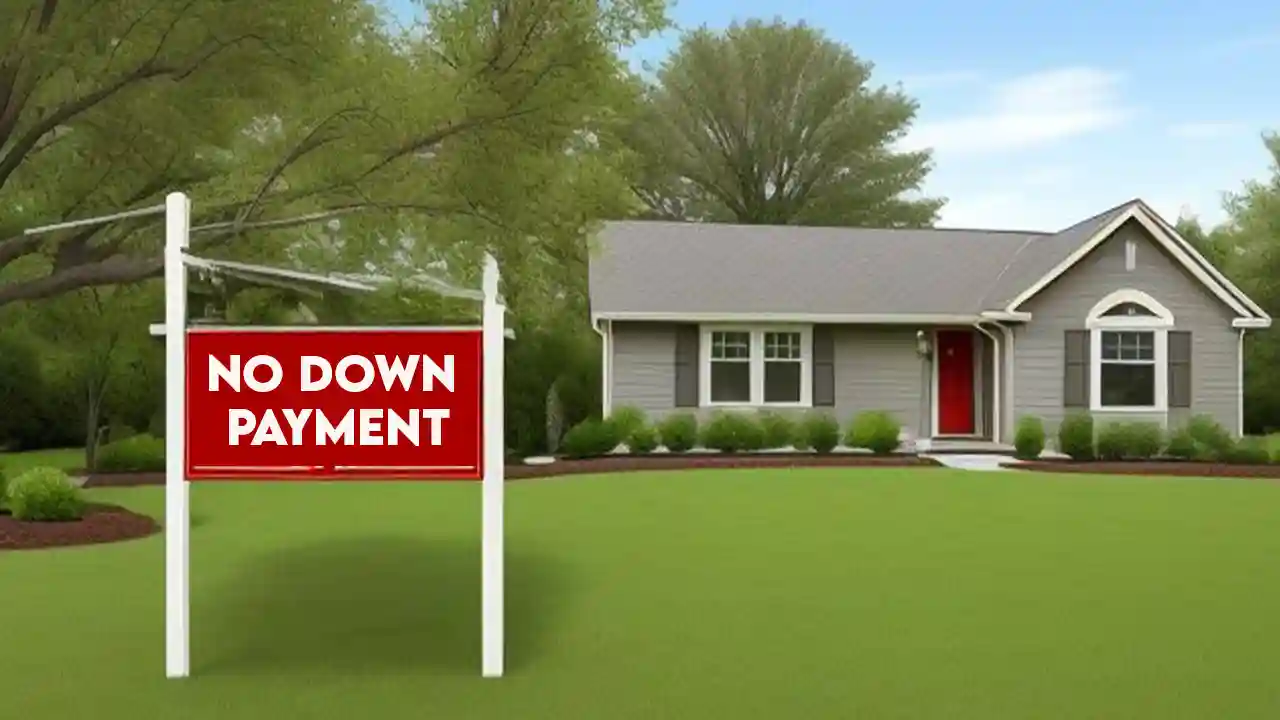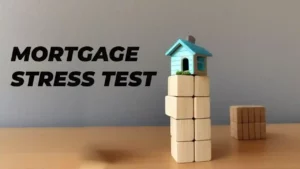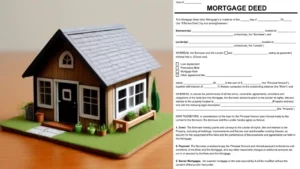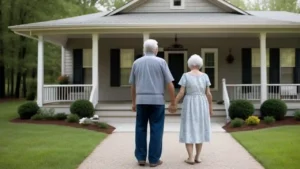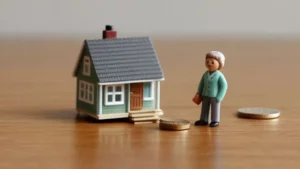Mortgagerateslocal.com – Buying a home is one of the biggest financial decisions you will ever make. It can also be one of the most challenging, especially if you don’t have enough money saved for a down payment.
A down payment is the amount of money you pay upfront when you buy a home, usually expressed as a percentage of the purchase price. For example, if you buy a home for $300,000 and you have a 10% down payment, you will pay $30,000 at closing and borrow $270,000 from the lender.
However, saving for a down payment can be difficult, especially for first-time home buyers who may have other financial obligations, such as student loans, car payments, or credit card debt. For many people, this amount can take years to accumulate.
By then, home prices vs interest rates may have risen, making homeownership even more expensive. Fortunately, there are ways to buy a home with no down payment, or a very low down payment. By the end of this post, you will have a better idea of how to achieve your dream of homeownership, even if you don’t have a lot of cash on hand.
What is a No Down Payment Mortgage?
A no down payment mortgage is a home loan that allows you to buy a home without paying any money upfront. This means that you can finance 100% of the purchase price of the home, and not have to worry about saving for a down payment.
A no down payment mortgage can be a great option for home buyers who have a steady income, a good credit score, and a low debt-to-income ratio, but lack the funds for a down payment.
There are two types of no down payment mortgages available: VA loans and USDA loans. These are both government-backed loans, which means that they are insured by the federal government, and have more lenient eligibility requirements than conventional loans, which are not backed by the government. Let’s take a closer look at each type of no down payment mortgage, and how they work.
VA Loans
VA loans are mortgages that are guaranteed by the Department of Veterans Affairs (VA). They are designed to help eligible veterans, active-duty service members, and surviving spouses buy, refinance, or improve a home. VA loans have many benefits, such as:
- No down payment required. You can buy a home with no money down, as long as the purchase price does not exceed the appraised value of the home.
- No PMI required. Unlike conventional loans, which typically require PMI if you put less than 20% down, VA loans do not require any mortgage insurance, which can save you hundreds of dollars per month.
- Low interest rates. VA loans have competitive interest rates that are often lower than conventional loans, which can save you thousands of dollars over the life of the loan.
- Flexible credit requirements. VA loans do not have a minimum credit score requirement, although most lenders will require a score of at least 620. However, VA loans are more forgiving of past credit issues, such as bankruptcy, foreclosure, or late payments, as long as you can show that you have improved your financial situation since then.
- No prepayment penalty. You can pay off your VA loan early, without paying any extra fees or charges, which can help you save on interest and build equity faster.
- Assumable. You can transfer your VA loan to another eligible borrower, such as a family member or a friend, who can assume your loan terms and payments, without having to apply for a new loan. This can be a useful feature if you need to sell your home quickly, or if interest rates rise in the future.
To qualify for a VA loan, you need to meet the following criteria:
- You must be a veteran, an active-duty service member, a member of the National Guard or Reserve, or a surviving spouse of a deceased veteran who died in service or as a result of a service-connected disability.
- You must have a valid Certificate of Eligibility (COE), which is a document that proves your eligibility for a VA loan. You can obtain a COE online, by mail, or through your lender.
- You must have a sufficient income to repay the loan, and a reasonable amount of residual income, which is the amount of money you have left over each month after paying your mortgage and other expenses. The VA has minimum residual income requirements based on your family size and location, which you can find here.
- You must have a satisfactory credit history, which shows that you have paid your debts on time and have not defaulted on any loans in the past. The VA does not have a specific credit score requirement, but most lenders will require a score of at least 620. However, if you have a lower score, you may still qualify if you can explain the reasons for your credit issues, and show that you have taken steps to improve your financial situation.
- You must occupy the home as your primary residence, and not use it as a vacation home or a rental property. You can buy a single-family home, a condo, a townhouse, a manufactured home, or a multi-unit property, as long as you live in one of the units.
The VA does not set a limit on how much you can borrow with a VA loan, but it does limit how much it will guarantee, which affects how much the lender will lend you. The VA loan limit is $548,250 for most counties in the U.S., but it can be higher in some high-cost areas.
You can find the VA loan limit for your county here. If you want to buy a home that costs more than the VA loan limit, you may have to make a down payment to cover the difference, or apply for a VA jumbo loan, which has stricter requirements and higher interest rates.
Another thing to consider when applying for a VA loan is the VA funding fee, which is a one-time fee that you pay to the VA to help cover the cost of the loan program. The VA funding fee varies depending on your loan type, your down payment amount, and your service category, but it typically ranges from 1.4% to 3.6% of the loan amount.
You can pay the VA funding fee at closing, or roll it into your loan balance. However, some borrowers are exempt from paying the VA funding fee, such as those who receive VA disability compensation, or those who are the surviving spouses of veterans who died in service or as a result of a service-connected disability.
USDA Loans
USDA loans are mortgages that are guaranteed by the U.S. Department of Agriculture (USDA). They are designed to help low- to moderate-income borrowers buy, refinance, or improve a home in a rural or suburban area. USDA loans have many benefits, such as:
- No down payment required. You can buy a home with no money down, as long as the purchase price does not exceed the appraised value of the home.
- Low interest rates. USDA loans have competitive interest rates that are often lower than conventional loans, which can save you thousands of dollars over the life of the loan.
- Low monthly mortgage insurance. Unlike conventional loans, which typically require PMI if you put less than 20% down, USDA loans require a small amount of mortgage insurance, which is also known as a guarantee fee. The guarantee fee consists of two parts: an upfront fee of 1% of the loan amount, which you can pay at closing or roll into your loan balance, and an annual fee of 0.35% of the loan balance, which is paid monthly. The guarantee fee helps the USDA cover the cost of the loan program, and protect the lender from losses if you default on your loan.
- Flexible credit requirements. USDA loans do not have a minimum credit score requirement, although most lenders will require a score of at least 640. However, USDA loans are more forgiving of past credit issues, such as bankruptcy, foreclosure, or late payments, as long as you can show that you have a stable income and a good payment history for the last 12 months.
- No prepayment penalty. You can pay off your USDA loan early, without paying any extra fees or charges, which can help you save on interest and build equity faster.
To qualify for a USDA loan, you need to meet the following criteria:
- You must have a low to moderate income, which means that your income does not exceed 115% of the median income for your area. You can find the income limits for your area here.
- You must buy a home in an eligible rural or suburban area, which means that the home is located in an area that has a population of less than 35,000. You can check the eligibility of your area here.
- You must occupy the home as your primary residence, and not use it as a vacation home or a rental property. You can buy a single-family home, a condo, a townhouse, a manufactured home, or a multi-unit property, as long as you live in one of the units.
The USDA does not set a limit on how much you can borrow with a USDA loan, but it does limit the loan amount based on your income, debt, and the area where you live. You can use this calculator to estimate how much you can afford with a USDA loan.
Pros and Cons of No Down Payment Mortgages
No down payment mortgages can be a great way to buy a home if you don’t have enough money saved for a down payment, or if you want to preserve your savings for other purposes, such as home improvements, emergencies, or investments. However, they also have some drawbacks that you should be aware of before you apply for one. Here are some of the pros and cons of no down payment mortgages:
Pros
- You can buy a home sooner. Saving for a down payment can take a long time, especially if you have other financial obligations or goals. With a no down payment mortgage, you can buy a home as soon as you find one that meets your needs and preferences, and take advantage of the benefits of homeownership, such as building equity, enjoying tax deductions, and having more control over your living space.
- You can take advantage of low interest rates. Interest rates are at historic lows, which means that you can lock in a low rate for your mortgage and save money on interest over the life of the loan. If you wait until you have enough money for a down payment, interest rates may rise, and you may end up paying more for your mortgage.
- You can access more home options. With a no down payment mortgage, you can buy a home that costs more than what you can afford with a down payment. This can give you more choices in terms of location, size, features, and amenities, and help you find a home that suits your lifestyle and needs.
- You can keep your savings for other purposes. With a no down payment mortgage, you don’t have to use your savings for a down payment, which means that you can keep them for other purposes, such as home improvements, emergencies, or investments. This can help you improve your home value, prepare for unexpected expenses, or grow your wealth.
Cons
- You will have a higher monthly payment. With a no down payment mortgage, you will borrow more money than if you had a down payment, which means that you will have a higher monthly payment. This can reduce your cash flow and limit your ability to save or spend on other things. You will also pay more interest over the life of the loan, since you will have a larger loan balance and a longer repayment term.
- You will have less equity in your home. Equity is the difference between the value of your home and the amount you owe on your mortgage. With a no down payment mortgage, you will start with zero equity in your home, and it will take longer to build equity, since you will pay more interest and less principal in the first years of the loan. Having less equity in your home can make it harder to sell or refinance your home, or to access your home equity through a home equity loan or a line of credit.
- You may have to pay extra fees or charges. With a no down payment mortgage, you may have to pay extra fees or charges, such as the VA funding fee or the USDA guarantee fee, which can add to your closing costs or your loan balance. You may also have to pay for an appraisal, a home inspection, or a survey, which are usually required by the lender to verify the value and condition of the home. These fees or charges can vary depending on the type of loan, the lender, and the home you buy, but they can add up to thousands of dollars.
- You may have less flexibility and security. With a no down payment mortgage, you may have less flexibility and security in case of a change in your financial or personal situation, such as a job loss, a divorce, or a health issue. If you need to sell or move out of your home, you may have a harder time finding a buyer or a renter, especially if the home value has declined or the market is slow. You may also have a harder time qualifying for a loan modification or a forbearance, which are programs that can help you lower or pause your mortgage payments if you face financial hardship. If you default on your loan, you may lose your home to foreclosure, and damage your credit score and your ability to get another loan in the future.
How to Apply for a No Down Payment Mortgage
If you have decided that a no down payment mortgage is the best option for you, you need to follow these steps to apply for one:
1. Check your eligibility
Before you apply for a no down payment mortgage, you need to make sure that you meet the eligibility requirements for the type of loan you want, whether it is a VA loan or a USDA loan. You can check your eligibility online, by mail, or through your lender, depending on the type of loan.
For example, if you want a VA loan, you need to obtain a Certificate of Eligibility (COE), which is a document that proves your eligibility for a VA loan. You can obtain a COE online, by mail, or through your lender. If you want a USDA loan, you need to check the income limits and the area eligibility for your location, which you can find on the USDA website.
2. Shop around for lenders.
Once you know that you are eligible for a no down payment mortgage, you need to shop around for lenders who offer the type of loan you want, and compare their interest rates, fees, and loan terms. You can use online tools, such as this one, to find and compare lenders who offer no down payment mortgages.
You can also ask for referrals from friends, family, or real estate agents, who have used no down payment mortgages before. You should get at least three quotes from different lenders, and choose the one that offers you the best deal and service.
3. Get pre-approved
After you choose a lender, you need to get pre-approved for a no down payment mortgage, which means that the lender will check your credit, income, and assets, and give you a letter that states how much you can borrow, and at what interest rate and terms.
Getting pre-approved can help you narrow down your home search, and show the seller that you are a serious and qualified buyer, which can give you an edge in a competitive market.
To get pre-approved, you need to fill out a loan application, and provide the lender with some documents, such as your ID, proof of income, bank statements, tax returns, and your COE if you want a VA loan. The lender will then review your application and documents, and give you a pre-approval letter, usually within a few days.
4. Find a home and make an offer
Once you get pre-approved, you can start looking for a home that meets your needs and preferences, and that fits your budget. You can use online tools, such as this one, to search for homes in your area, and filter them by price, size, features, and amenities.
You can also work with a real estate agent, who can help you find and view homes, and negotiate with the seller on your behalf. When you find a home that you like, you need to make an offer, which is a written proposal that states how much you are willing to pay for the home, and under what conditions.
Your offer should include the purchase price, the earnest money deposit, the closing date, the contingencies, and any other terms that you want to include. Your real estate agent can help you prepare and submit your offer, and communicate with the seller or their agent.
The seller can accept, reject, or counter your offer, depending on how they feel about it. If they accept your offer, you have a binding contract, and you can move on to the next step. If they reject your offer, you can either walk away, or make another offer. If they counter your offer, you can either accept their counteroffer, reject it, or make another counteroffer, until you reach an agreement or walk away.
5. Get a home inspection and appraisal
After you have a contract with the seller, you need to get a home inspection and appraisal, which are usually required by the lender to verify the condition and value of the home. A home inspection is a visual examination of the home’s structure, systems, and components, performed by a licensed professional, who will check for any defects, damages, or safety issues, and give you a report that details their findings and recommendations.
A home inspection can help you identify any problems with the home, and request repairs or credits from the seller, or back out of the deal if the problems are too serious. A home appraisal is an estimate of the home’s market value, based on its location, size, features, and condition, and compared to similar homes that have sold recently in the area.
An appraisal is performed by a licensed appraiser, who will visit the home, take measurements and photos, and give you a report that states their opinion of the home’s value. An appraisal can help you determine if the home is worth what you agreed to pay for it, and if the loan amount is appropriate.
If the appraisal comes in lower than the purchase price, you may have to renegotiate the price with the seller, or make up the difference with your own money, or cancel the contract if you have an appraisal contingency. If the appraisal comes in higher than the purchase price, you have more equity in the home, and you can proceed with the deal.
6. Finalize the loan and close the deal
After you get the home inspection and appraisal, and everything is satisfactory, you need to finalize the loan and close the deal, which means that you will sign the loan documents, pay the closing costs, and get the keys to your new home.
To finalize the loan, you need to provide the lender with any additional documents or information that they may request, such as proof of homeowners insurance, title insurance, or a final walkthrough of the home.
The lender will then review your loan file, and give you a final approval, and a closing disclosure, which is a document that summarizes the final loan terms, costs, and payments. You should review the closing disclosure carefully, and compare it to the loan estimate, which is a document that you received when you applied for the loan, and that shows the estimated loan terms, costs, and payments.
You should look for any errors or changes, and ask the lender to explain or correct them, if necessary. To close the deal, you need to attend a closing meeting, which is usually held at a title company, an escrow agency, or an attorney’s office, depending on your state.
At the closing meeting, you will meet with the seller, their agent, your agent, the lender, and the closing agent, who is a neutral third party who handles the paperwork and the money. You will sign the loan documents, such as the promissory note, the deed of trust, and the closing disclosure, and pay the closing costs, which are the fees and charges that you have to pay to finalize the loan and the purchase.
The closing costs can vary depending on the type of loan, the lender, and the home, but they typically range from 2% to 5% of the loan amount. You can pay the closing costs with a cashier’s check, a wire transfer, or a credit card, depending on the lender’s policy.
The seller will sign the deed, which is a document that transfers the ownership of the home to you, and hand over the keys to your new home. The closing agent will record the deed and the deed of trust with the county recorder’s office, and disburse the funds to the seller and the lender. Congratulations, you are now a homeowner!
Conclusion
Buying a home with no down payment is possible, if you qualify for a VA loan or a USDA loan, which are both government-backed loans that allow you to finance 100% of the purchase price of the home. By following these steps, you can achieve your dream of homeownership, even if you don’t have a lot of cash on hand.
